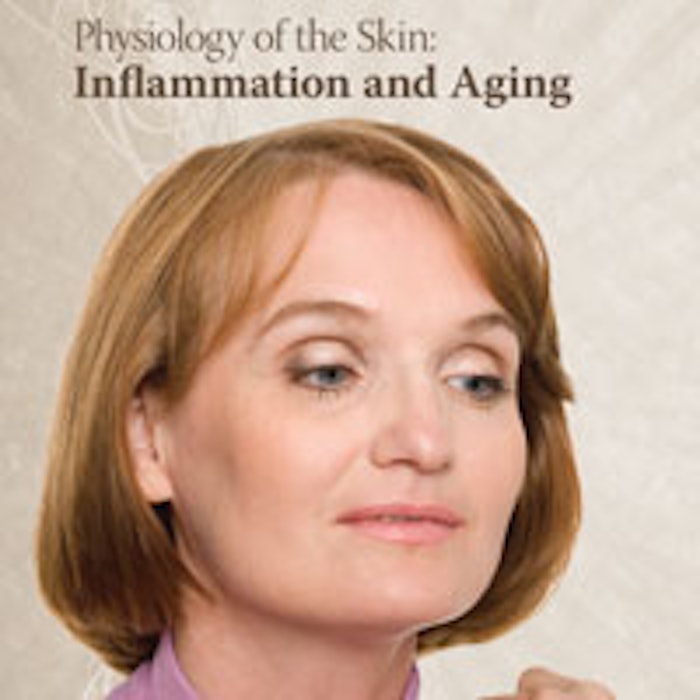
Despite many years of intense research on the cause of aging, it is still not fully understood, although general consensus is that chronic inflammation appears to be a major underlying factor. It is known that aging is a complex process that has both genetic and environmental components. It is also known that, in many cases, aging is not always systemic. The process of aging results in an increase of inflammatory cytokines, which are chemicals that are cell signals responsible for many of the degenerative diseases that are associated with aging.1 Rheumatoid arthritis is a classic chronic inflammatory disease associated with excess levels of cytokines that include tumor necrosis factor-alpha (TNF-a), interleukin-6 and NF-kappaB (NF-kB), which are known to cause or contribute to the inflammatory syndrome. In this article, the three known causes of chronic inflammatory disease associated with aging will be addressed, including NF-kB, oxidative damage and the effects of ultraviolet (UV) light on the skin.
NF-kB
NF-kB is a critical compound in body protection, and in the initiation of inflammation. When it is in excess or if it is stimulated by some pathological condition, it can produce both acute and chronic inflammation.2 One of the compounds that is capable of stimulating NF-kB production is known as an advanced glycation end product (AGE). Glycation is the binding of a protein molecule to a glucose molecule, or a fat molecule, resulting in the formation of abnormal protein structures. Many known age-related diseases, such as cataracts and neurological impairment, are at least partially attributable to glycation. These glycation end products contain reactive chemical groups that can combine with proteins and lipids, and cause insoluble complexes.3 These complexes, while biologically active, are physiologically abnormal and thus are capable of entering into cellular reactions that are related to the production of inflammatory components, particularly the cytokines. Foods that are cooked above 140°C will undergo glycation. Frying, baking, broiling and roasting all are done at temperatures in excess of 300°C.
One of the ways that the action of NF-kB can be avoided is to decrease the intake of AGE products. Although this may seem to be an extremely difficult change in the diet, it actually is not quite that bad. As of now, the safe amount of intake of glycation products is unknown. Consider that 100 g of roast chicken skin contains more than six million glycation units.
Cooking foods at high temperatures results in a browning effect, where sugars and certain oxidized fats react with proteins to form glycation products in the food. A person’s diet plays a major role in chronic inflammatory processes.4 Eating too much overcooked food causes an increase in inflammatory cytokines, which can lead to chronic inflammatory disease. It is known that junk foods are cooked at extremely high temperatures, so avoid french fries, hamburgers, potato chips, fried foods and other snacks.
Oxidative damage
Free radical damage was one of the first processes associated with aging; it actually goes back to the 1950s when Denham Harman, MD, PhD, first proposed oxidation as a mechanism for tissue destruction. The aging process is a deterioration of metabolic balance, or homeostasis; therefore, aging is accompanied by an alteration in the impairment of physiological systems, such as the immune system. One target of oxidative damage within the cell is an organelle known as the mitochondria, which applies the major portion of energy to the cell and also consumes more than 90% of the oxygen coming into the body. It is interesting that this oxidation-mitochondrial process is associated with aging, and that the age-related changes of immune functions have their basis in oxidative and inflammatory stress situations. These have among their intracellular mechanisms the activation of NF-kB in immune cells. Now the relationship between oxidation and immune function can be seen, as can the relationship between that process and the production of NF-kB in immune cells. This association adds a great deal of weight to a relatively new theory of aging known as oxidation-inflammation.5
Chronic oxidative stress affects all cells, especially cells of the nervous, endocrine and immune systems, as well as the communication between them, and all the processes that involve cellular regulation. Once biological homeostasis is upset, the preservation of health is at peril. A key involvement of the immune system in the aging process of the organism concerns the rate of aging—because there is a relation between the degree of oxidative damage and the functional capacity of the immune cells—and therefore the longevity of individuals. More than 40 years ago, the immune system was proposed as a major target of aging and, only now, are scientists beginning to see the relationship between the immune system and the process of aging linked together by oxidative damage.6 The addition of adequate amounts of antioxidants in the diet improves immune function, decreasing oxidative stress and, consequently, increasing longevity.
Certain neurodegenerative diseases, such as Alzheimer’s disease and multiple sclerosis as well as amyotrophic lateral sclerosis, have been associated with oxidative damage. A major target of oxidative damage is the mitochondria, since approximately 95% of the body’s intake of oxygen must pass through the mitochondria in the process of oxidative metabolism. Because the mitochondria supplies the major portion of energy to the cell, and therefore to the body, any process that damages mitochondria will have a major impact on the body physiology.
Body weakness is often the first sign associated with mitochondrial damage. Because every cell needs a large supply of energy in order to carry out the daily metabolic processes, they will undergo internal damage, eventually resulting in dysfunction of a particular cell, which is then manifested by organ malfunction. There appears to be a rather complex relationship between oxidative damage and protein metabolism that results in cellular damage on a molecular basis.7 Often, this damage is actually produced by the body itself in response to some exogenous or endogenous factor that the body recognizes as a foreign material. For example, a diet high in glycation products, such as that which results from high-heat cooking, can be very harmful to diabetic individuals who have high blood sugars. These sugar molecules will cross-link with proteins and fat molecules to produce an excessive amount of AGEs, which then react with cellular receptors to produce inflammatory reactions. This is one reason that antioxidant and nutritional therapy are being employed in several metabolic disorders in an attempt to reduce this internal stress on the body.
UV damage the skin
There is no question that UV rays have a very adverse effect on skin. Both the epidermis and dermis can be severely damaged by excessive exposure to energy in the range of 290–400 nm, which covers both the UVA and UVB spectra. The skin is one of the major target organs of UV exposure. Within this, the immune system is particularly vulnerable. In the presence of an inflammatory reaction, which is the body’s response to infection or injury, there can be an actual accentuation of the inflammatory mechanism, such that it amplifies the defensive response, which can result in molecular damage to not only DNA, but also to other proteins, such as enzymes and immune-response proteins.8 Some of these responses can actually produce immune suppression, as well as cancer and classic photoaging.
There are many induced immune-regulatory and pro-inflammatory mediators produced by the body at the gene-expression level. A full understanding of the cutaneous immune system’s response to photo-skin interactions is not yet known, but it is essential to fully protect the skin from adverse solar effects. The protection of current sunscreen products is measured only as a reduction in redness (the current SPF value), and this may no longer be sufficient, because it is clear that protection against UV-induced immune changes is of equal—if not of greater—importance. A great deal more information about these processes is needed in order to continue the development of improved strategies to repair photodamaged skin.
Histological changes of chronological aging skin show thinning of the stratum spinosum and some flattening of the dermo-epidermal junction. The sun-protected epidermis, on the other hand, shows epidermal thickness that is increased in sun-exposed skin. Why this thickness occurs remains unknown, though it is believed to be associated with some cellular mechanism that prevents apoptosis, or programmed cell death.9 Growth factors that are associated with inflammation may contribute to early tumor formation. As an example, melanocyte growths are seen as a result of the inflammatory process producing nevi and other pigmented lesions, as well as hypomelanosis, which can occur in photo-exposed areas. This accounts for a great deal of the immune damage visible after sun exposure that is intense enough to result in a burn.
In the dermal region of aging skin, a reduced number of fibroblasts are generally found, which not only produce less collagen then younger fibroblasts, but also produce more collagenase, the enzyme that destroys collagen. It appears that this is one of the major reasons that aging skin sags, as well as one of the reasons that reconstructing aging skin is so difficult. Of course, the amount of elastin in sun-damaged skin associated with aging is increased, but functionally is quite abnormal; aging skin shows histological changes that include an increased amount of cross-linking of collagen fibers.
Although this cross-linking is an enzymatic process, there is also associated nonenzymatic cross-linking that appears to be due to glycation. Both of these processes are characteristic of photodamaged skin. The amount of UV light reaching the dermis depends not only on the duration of exposure, but also on the intensity of the radiation. For example, UVA, although it penetrates deeper into the dermis than UVB, is more frequently associated with collagen damage and aging changes, while UVB damages the epidermis most frequently and is a major cause of skin cancer. The radiation intensity from UVB is 1,000 times stronger than that of UVA radiation. Skin changes resulting from chronic UV exposure show classic collagen changes with the increased levels of collagen Type III, along with abnormal, thickened, tangled and nonfunctional elastic fibers. Eventually these tissue changes result in tissue that is degenerated into a nonfibrous, amorphous mass—a finding known histologically as solar elastosis.10 It is this process that produces classic sun-damaged skin seen in inveterate sun worshipers. The bottom line is that there is no safe way to tan, because increased pigmentation appears to be a sign that some degree of inflammation has taken place.
REFERENCES
1. AA Podtelezhnikov, et al, Molecular insights into the pathogenesis of Alzheimer’s disease and its relationship to normal aging, PLoS One 6 12 :e2961 (2011)
2. SC Gupta SC, et al, Role of nuclear factor B-mediation in inflammatory pathways in cancer-related symptoms and their regulation by nutritional agents, Exp Biol Med 236 6 658–671 (Jun 1, 2011)
3. DR Sell, Molecular Basis of Arterial Stiffening: Role of Glycation, Gerontology (Jan 4, 2012) (E-pub ahead of print)
4. A Anogeianaki, et al, Atherosclerosis: a classic inflammatory disease, Int J Immunopathol Pharmacol 24 4 817–825 (Oct 2011)
5. R Tacutu, et al, Molecular links between cellular senescence, longevity and age-related diseases—a systems biology perspective, Aging (Dec 18, 2011) (E-pub ahead of print)
6. S Le Saux, et al, Mechanisms of immunosenescence: lessons from models of accelerated immune aging, Ann NY Acad Sci (Jan 6, 2012) (E-pub ahead of print)
7. TC Squier, Oxidative stress and protein aggregation during biological aging, Exp Gerontol 36 9 1539–1550 (Sep 2001)
8. N Pustisek and M Situm, UV-radiation, apoptosis and skin, Coll Antropol 35 Suppl 2 339–341 (Sep 2011)
9. J Krutmann, et al, Sun Exposure: What Molecular Photodermatology Tells Us About Its Good and Bad Sides, J Invest Dermatol (Dec 15, 2011) (E-pub ahead of print)
10. L. Baillie, et al, Strategies for assessing the degree of photodamage to skin: a systematic review of the literature, Br J Dermatol 165 4 735–742 (Oct 2011)
Peter T. Pugliese, MD, is a biomedical consultant, and his research has led to the development of his own professional skin care line, Circadia by Dr. Pugliese. He received his medical degree from the University of Pennsylvania School of Medicine in Philadelphia, and he is the author of several books, and is the co-author of Physiology of the Skin, Third Edition (2011). He also is a member of the 2011–2012 Skin Inc. magazine editorial advisory board.
Michael Pugliese is the CEO of Circadia by Dr. Pugliese and the Circadia Institute of Advanced Esthetics, where he and grandfather Peter T. Pugliese, MD, hold in-depth classes on a variety of subjects including cosmetic chemistry and histology of the skin. He is a licensed esthetician in the state of Pennsylvania and holds a degree in business management and marketing from Kutztown University in Kutztown, Pennsylvania.











